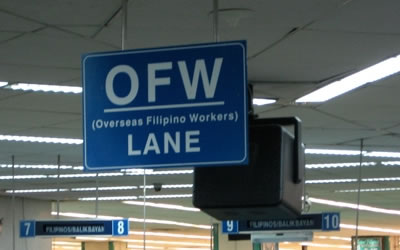With the introduction of the Republic Act 9679, otherwise known as the Home Development Mutual Fund Law of 2009 or simply Pag-IBIG Fund Law of 2009, a number of changes have been implemented to the existing rules of the Pag-IBIG Fund.
This article touches those affecting the Overseas Filipino Workers and those things that are most important to them.
1. Mandatory Membership
In the past, membership to the Pag-IBIG Fund by OFW and migrant Filipinos is only voluntary under the Pag-IBIG Overseas Program. But that’s not the case any more since the introduction of the Pag-IBIG Fund Law of 2009, which took effect last January 2010. All Overseas Filipino Workers (OFWs) and Filipino Seafarers are already required to become members of the Pag-IBIG Fund. Those who have been to the Office of the Philippine Overseas Employment Agency will tell you that they were made to pay for Pag-IBIG Fund Membership there. A lot of OFWs are not aware of this, but you who are reading this article should not be surprised any more.
(Please be concerned with your fellow OFW friends and share this article to them.)
2. Membership Application
 Instead of catching yourself unprepared for this thing at the POEA Office, it’s best if you are the one to enroll yourself to become a member of the Pag-IBIG Fund. To do this, please visit any of the following offices:
Instead of catching yourself unprepared for this thing at the POEA Office, it’s best if you are the one to enroll yourself to become a member of the Pag-IBIG Fund. To do this, please visit any of the following offices:
- If you are based overseas, please visit the Philippine Consular Office or Philippine Embassy in your host country.
- Locally in the Philippines at the following:
- Any Pag-IBIG Fund Branch
- Pag-IBIG Satellite Office at the POEA
- For all OFW concerns, don’t forget this office:
Pag-IBIG Fund International Operations Group
6th Floor, Justine Bldg.,
Gil Puyat Avenue, Makati City
3. Contribution Rate
When it comes to the amount of contribution, Pag-IBIG doesn’t distinguish anymore between a locally based Pag-IBIG Member and that of an OFW Member. They are all under the Regular Pag-IBIG Membership likewise known as the Pag-IBIG I Membership. In other words, the contribution is only P 200 per month. And since there is no employer counter-part for OFW’s, you have to shoulder it all by yourself.
Take note that you may be asked to upgrade your contribution once you are approved a housing loan.
See also this article: “How Your Income And Contributions Affect Your Housing Loan Entitlement”
4. About The POP Membership
Some of you may have been a member of the Pag-IBIG Overseas Program (POP) already. Please bear in mind that POP is entirely different from Pag-IBIG I. While POP is optional for OFWs, Pag-IBIG I membership is mandatory since 2010 (refer to #1 above). Since the two programs are separate, your contributions to POP will not be merged with your Pag-IBIG I membership.
If you have been contributing for the POP Program, it would be to your advantage if you continue with it until it reaches maturity period where you are become entitled to withdraw your funds with its TAV.
Take note also that for other POP members, like the migrant Filipinos who are not OFWs, the membership to the Pag-IBIG I is only voluntary
( See also: Overview of Pag-IBIG Overseas Program )
5. Benefits of Pag-IBIG Membership
Basically, there are three benefits that all Pag-IBIG Members are entitled to.
- Housing Loan – this is the most popular and the most attractive benefit.
- Short Term Loan (Multi-Purpose and Calamity Loans) – a non-collateral loan that you can use for anything.
- Provident Savings – Pag-IBIG Fund’s Saving Program for its members.
For a detailed explanation of these benefits, please refer to this article: “Benefits of Becoming A Pag-IBIG Fund Member”.
~~~
“Top 5 Things Every OFW Should Know About The New Pag-IBIG Law of 2009” is written by Carlos Velasco.

 Thanks for this initiative, paying for your Pag-IBIG Fund dues is made even more convenient with Pag-IBIG’s tie-up partnership with the country’s biggest bank. These banks have the most branches scattered all over the country and even abroad so making your payment should not be a problem anymore.
Thanks for this initiative, paying for your Pag-IBIG Fund dues is made even more convenient with Pag-IBIG’s tie-up partnership with the country’s biggest bank. These banks have the most branches scattered all over the country and even abroad so making your payment should not be a problem anymore.  In the case of Pag-IBIG Fund, one of the ways they can check this is by simply looking at your membership records with the Fund. Ever wonder why the Pag-IBIG Fund requires its members to have contributed at least 24 months of contributions? The very reason is that, they want to make sure that you have a steady source of income for the past two years. Somehow that gives them a hint of your employment record.
In the case of Pag-IBIG Fund, one of the ways they can check this is by simply looking at your membership records with the Fund. Ever wonder why the Pag-IBIG Fund requires its members to have contributed at least 24 months of contributions? The very reason is that, they want to make sure that you have a steady source of income for the past two years. Somehow that gives them a hint of your employment record.  The wise buyer keeps everything in proper perspective. You want to be able to enjoy living in your house with your family so that eventually you can call it a home. And at the same time, you don’t want it to be too much of a drain on your finances.
The wise buyer keeps everything in proper perspective. You want to be able to enjoy living in your house with your family so that eventually you can call it a home. And at the same time, you don’t want it to be too much of a drain on your finances. 